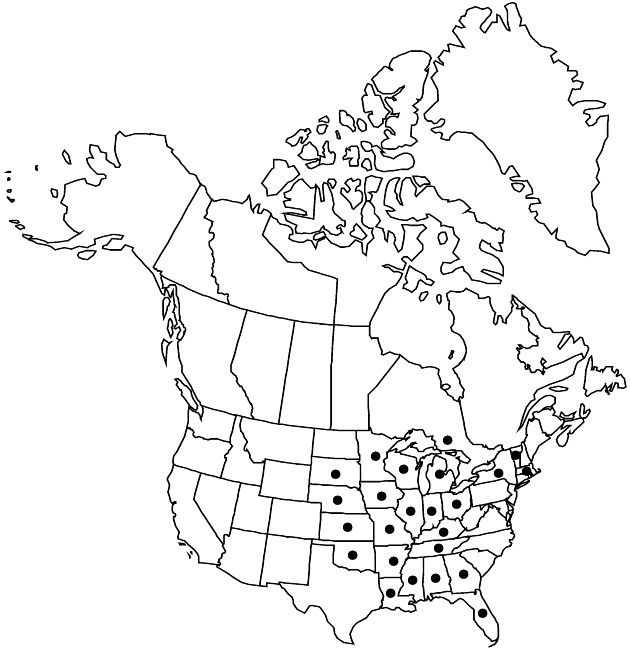Difference between revisions of "Ratibida pinnata"
Bull. Torrey Bot. Club 24: 410. 1897.
FNA>Volume Importer |
imported>Volume Importer |
||
| (4 intermediate revisions by 2 users not shown) | |||
| Line 8: | Line 8: | ||
}} | }} | ||
|common_names=Grayhead or pinnate prairie coneflower | |common_names=Grayhead or pinnate prairie coneflower | ||
| + | |special_status={{Treatment/ID/Special_status | ||
| + | |code=F | ||
| + | |label=Illustrated | ||
| + | }}{{Treatment/ID/Special_status | ||
| + | |code=E | ||
| + | |label=Endemic | ||
| + | }} | ||
|basionyms={{Treatment/ID/Basionym | |basionyms={{Treatment/ID/Basionym | ||
|name=Rudbeckia pinnata | |name=Rudbeckia pinnata | ||
|authority=Ventenat | |authority=Ventenat | ||
| + | |rank=species | ||
|publication_title=Descr. Pl. Nouv., plate | |publication_title=Descr. Pl. Nouv., plate | ||
|publication_place=71. 1802 | |publication_place=71. 1802 | ||
| Line 37: | Line 45: | ||
-->{{#Taxon: | -->{{#Taxon: | ||
name=Ratibida pinnata | name=Ratibida pinnata | ||
| − | |||
|authority=(Ventenat) Barnhart | |authority=(Ventenat) Barnhart | ||
|rank=species | |rank=species | ||
| Line 51: | Line 58: | ||
|publication title=Bull. Torrey Bot. Club | |publication title=Bull. Torrey Bot. Club | ||
|publication year=1897 | |publication year=1897 | ||
| − | |special status= | + | |special status=Illustrated;Endemic |
| − | |source xml=https:// | + | |source xml=https://bitbucket.org/aafc-mbb/fna-data-curation/src/2e0870ddd59836b60bcf96646a41e87ea5a5943a/coarse_grained_fna_xml/V19-20-21/V21_139.xml |
|tribe=Asteraceae tribe Heliantheae | |tribe=Asteraceae tribe Heliantheae | ||
|subtribe=Asteraceae (tribe Heliantheae) subtribe Rudbeckiinae | |subtribe=Asteraceae (tribe Heliantheae) subtribe Rudbeckiinae | ||
Latest revision as of 20:10, 5 November 2020
Perennials, to 125+ cm; fibrous rooted (arising from stout rhizomes or woody caudices). Leaves 5–40 × 3–15+ cm, pinnatifid to pinnate, lobes 3–9, narrowly lanceolate to ovate, 1–15 × 0.2–3.5 cm, faces strigose, gland-dotted. Heads mostly 1–12, held well beyond leaves. Peduncles 3–27+ cm (ribs tan, prominent). Phyllaries 10–15, outer linear, 3–15 × 1–3 mm, inner lanceolate-ovate, 3–6 × 0.7–3 mm. Paleae 1.2–5 × 1–1.8 mm, resin glands linear to oblanceolate, 2–3.3 mm. Ray florets 6–15; corollas yellow, 2.5–3.8 mm, tubes ca. 1–3 mm, hirsute, laminae linear-elliptic to oblong-oblanceolate, 16–60 × 4–15 mm. Discs ellipsoid to globular or ovoid, 10–25 × 10–18 mm. Disc florets 100–200+; corollas greenish yellow, often purplish distally, 2.5–3.8 mm; style branches ca. 1.8 mm, proximal 1/2 stigmatic, apices subulate. Cypselae linear-oblanceoloid, 2–4 × 1–2.3 mm, margins usually glabrous, sometimes adaxial ciliate; pappi 0 or of 1–2 toothlike projections. 2n = 28.
Phenology: Flowering May–Oct.
Habitat: Prairies, woodland openings and borders, limestone outcrops
Elevation: 10–300 m
Distribution

Ont., Ala., Ark., Fla., Ga., Ill., Ind., Iowa, Kans., Ky., La., Mass., Mich., Minn., Miss., Mo., Nebr., N.Y., Ohio, Okla., S.Dak., Tenn., Vt., Wis.
Discussion
Selected References
None.
